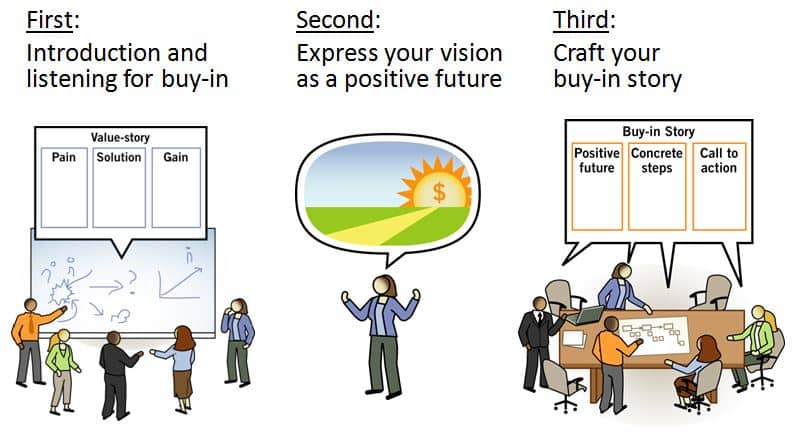How to Get Buy-In for Procedures

In any organization, implementing new procedures can be a daunting task. Even if the procedures are designed to improve efficiency, productivity, and overall performance, getting buy-in from employees can sometimes feel like an uphill battle. However, gaining support for new procedures is essential for their successful adoption and implementation.
Getting Buy-in for Procedures
Along with communication, training and auditing, there is the concept of buy-in. What are reasons procedures aren’t getting used and how do you gain buy-in for procedures?
What D0 We Mean by Buy-in?
Basically, buy-in is getting people to believe. In the context of procedures, buy-in is getting people to believe that having, following, and maintaining procedures is good and important for the organization as well as for their department and them individually. If they believe the procedure is necessary and helpful, as opposed to just another pointless and burdensome exercise in bureaucratic futility, then the odds of them accepting the procedure as part of their work life will be exponentially enhanced.
Buy-in Starts with Communication
Communicate the Why. Before introducing new procedures, clearly communicate the reasons behind the change. Help employees understand the purpose and benefits of the new procedures. Whether it’s to streamline processes, enhance quality, or ensure compliance, explaining the rationale behind the changes can make them more receptive to the idea.
Clear communication and training are part of gaining acceptance. Too often documents like procedures fall from the sky with little explanation, and then organizational leaders wonder about the lack of awareness or commitment to following procedures. We know that explaining why the procedure is necessary is one part of gaining acceptance. Getting buy-in is a key facet of communication about the procedure.
Formula for Gaining Buy-In
As mentioned above, buy-in is about getting people to believe. Another way to think of buy-in, however, is gaining their understanding, commitment, and action in support of a goal. Dictating actions may work in the short term, but it will rarely result in long term change. As soon as the attention or spotlight is elsewhere, they will return to their old ways of doing things. Long term change happens when people believe in it.
There is a basic formula that can at least be a starting point for gaining buy-in:
Dissatisfaction + Vision + First Steps > Resistance to Change
When you overcome resistance to change, then you have conquered a very big obstacle – they are willing to embrace something different, and that goes against the nature of most us.
Identifying Dissatisfaction Takes Effort
One element of why procedures are needed should be how the procedure is going to help solve some of their problems. For example, with a documented process there should be less doubt and confusion. A clear, defined path is written down for them.
Finding and using dissatisfaction, however, is very situational. You have to put in the effort of talking, and especially listening, to people in order to understand what they are dissatisfied about. Then you have figure out the role of a procedure in resolving it.
The Importance of Vision
One reason we fear change is that it means the future is less certain. Uncertainty leads to stress and confusion. What we are currently doing is familiar and comfortable. Changes take these comforting elements away. Expressing a clear vision of a positive future is an important element of buy-in.
A vision of a positive future must include a positive future for everyone. For example, streamlining a process in a way that leads to cuts in staff is not expressing a positive future for those potentially facing pink slips. Express a positive vision for only a select few and your effort to gain buy-in will certainly fail. A vision, however, of a growing, successful organization that is inclusive and provides opportunities for advancement is another story.
A vision without first steps usually leads to frustration. Talking about a glorious future without any concrete details of what you want them to do can leave people bewildered and anxious. On the other hand, laying out lengthy, detailed plans for the long term can be overwhelming, so they end up doing nothing.
The idea is to tell them what they need to do today, tomorrow, and next week without confusing them with too many details about next year or five years from now. They need to know some concrete first steps they should take.
Conversely, first steps without a clear vision usually leads to false starts and flavor of the months programs that end up leaving the staff discouraged and wary of change. Explaining why is important, but just as important is getting them to believe your explanation. That is why buy-in is so important.
Involve Employees in the Process
When employees feel like they have a voice in the decision-making process, they are more likely to support the resulting changes. Involve employees in discussions about the new procedures, solicit their feedback, and incorporate their ideas where possible. This sense of ownership can increase their commitment to the implementation process.
Monitor Progress and Provide Feedback
Continuously monitor the implementation of the new procedures and provide feedback to employees. Celebrate successes and address any challenges or obstacles that arise along the way. Keep the lines of communication open and be responsive to employee concerns.
Schedule Audits to Ensure Procedures Are Used
After you’ve achieved buy-in, the next step is follow-up with auditing. Here auditing refers to observing compliance to the process documentation (the procedure). How is the process conducted? Does it match the procedure? Are people aware of the procedure and whether or not it is followed?
Hopefully, the audit will find that the procedure is being followed, but if it does not then an analysis should follow to determine why. As always, the focus should be on determining where corrections need to be made in the system, and not on blaming individuals.
In any case, if issues are found with the procedure (with awareness, correctness, etc.) during the audit, corrective action is taken and a follow up audit scheduled for the not too distant future. Ignoring the problem will not likely lead to a solution.
Training and Auditing
Offer comprehensive training to ensure that employees understand the new procedures and feel confident in their ability to follow them. Provide support resources, such as job aids, manuals, or online tutorials, to help employees navigate the transition.
Address any concerns or questions they may have along the way. These are the keys to having procedures used and followed. Start with training to ensure the proper awareness and buy-in, and then follow-up with auditing to reinforce the importance of using the procedure.
Address Why Procedures are not Used
One way to find reasons procedures are not used is to think about how procedures are released. Does the release process include communication to all the affected departments and processes? Communication doesn’t mean the procedure falls from the sky and arrives at the department along with a stack of other interdepartmental memos, documents and correspondence.
The release of newly developed or revised procedures should be accompanied by training that clearly explains why procedures are needed, why they were written, and why they should be used and followed. Having all the affected staff attend training directed at achieving those goals obviously creates an awareness of it. Attendees now know what it is called, its nomenclature (document number), what it looks like, what’s in it, and how to find it.
But let’s not gloss over all these “whys” too quickly. Answering these questions in a clear and straightforward way is the key to getting buy-in. And buy-in is what is really needed to make the idea of using the procedures stick. If you, however, as the compliance manager, department head, or process owner, do not have all the answers to these “why” questions, then the real question is – why was the procedure written in first place?
Are There Too Many Procedures?
Another one of the reasons procedures are not used is that there are just too many of them. An organization’s world of procedures may be a confusing maze some are unable to navigate and make sense of. Figuring out what procedures are truly needed (and why) and eliminating the rest can reduce confusion and complexity, and lead to procedures being better used and followed. Taking a lean approach to procedures in conjunction with other methods of communicating organizational knowledge (like training) can make a big difference not only in how people use procedures, but also their attitude toward them.
Additional Strategies to Help Get Buy-in for Procedures
Wait, we’re not done… What are some additional strategies to help you get buy-in for procedures? Consider leading by example, recognizing and rewarding procedure compliance, or highlighting the procedure benefits.
Lead by Example
Demonstrate your own commitment to the new procedures by following them yourself. Lead by example and show employees that you believe in the changes. When they see management actively embracing the new procedures, they are more likely to follow suit.
Recognize and Reward Procedure Compliance
Acknowledge and reward employees who embrace the new procedures and demonstrate adherence to them. Whether it’s through verbal praise, incentives, or performance bonuses, recognizing their efforts can reinforce positive behavior and encourage others to follow suit.
Highlight the Procedure Benefits
Emphasize how the new procedures will benefit both the organization and the employees themselves. Will it save time? Improve accuracy? Reduce errors? Increase job satisfaction? By illustrating the positive outcomes of the new procedures, you can help employees see the value in embracing the change.
Winning Hearts and Minds: How to Get Buy-In for Procedures
By employing these strategies, you can effectively garner buy-in for new procedures within your organization. Remember, successful implementation requires not only clear communication and training but also a supportive and inclusive approach that values the input and engagement of employees at all levels. With their support, you can achieve greater efficiency, productivity, and success for your organization as a whole.

















This is an excellent approach to achieving buy-in.
As a trained manager of over 30 years I find this procedure a good summary of the Buy-in Process. It should be helpful to managers and all their staff.